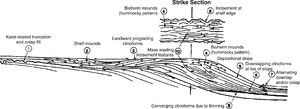Predicting carbonate reservoir location and quality
| Exploring for Oil and Gas Traps | |

| |
| Series | Treatise in Petroleum Geology |
|---|---|
| Part | Predicting the occurrence of oil and gas traps |
| Chapter | Predicting reservoir system quality and performance |
| Author | Dan J. Hartmann, Edward A. Beaumont |
| Link | Web page |
| Store | AAPG Store |
Reservoir quality is defined as the “ability of a reservoir to store and transmit oil or gas.” We also can include the thickness and lateral extent as aspects of reservoir quality.
Procedure: predicting location and quality
How do we predict the quality of a carbonate reservoir? The procedure outlined below is one way to approach this problem. Use the parts of the suggested procedure that fit your situation.[1][2][3]
- Make regional strike and dip stratigraphic cross sections.
- Break down cross-section stratigraphy into sequences and parasequences (see Fourth- and fifth-order sequences (Parasequences)).
- Group parasequences into sets by identifying progradational, aggradational, or retrogradational patterns within sets. Make isopachs of systems tracts using parasequence sets and their correlation surfaces.
- Map paleogeography and facies tracts through time using systems tract maps; use core and log data to infer shorelines and platform edge locations.
- Study known accumulations that occur within the target formation.
- What are the trap types?
- What are the pore types, pore geometry, thickness, and lateral extent of porous facies?
- What are the facies sequences within parasequences?
- How does facies distribution relate to trapping?
- Put known accumulations into the paleogeographic framework. Are they near the platform edge or near the shoreline? Nearshore sea level cycles cause more frequent changes in pore-water chemistry than offshore where subsidence is greater. Therefore, the diagenetic evolution of carbonate sediment is less complex offshore.
- Put known accumulations into a sequence stratigraphic framework. Were reservoir rocks deposited in transgressive, highstand, or lowstand systems tracts?
- Put target formation in a global and regional climatic framework. At the time of deposition, was the global climate in greenhouse, icehouse, or transitional conditions? Was the local climate arid or humid? Do expected geologic features due to climate correlate with observed features?
- Predict reservoir location and quality using knowledge of known accumulations and regional geologic framework developed above.
- Can you find undrilled areas that share similar qualities to areas that produce from the target formation?
- If prospects exist, will reservoir quality be similar?
- If not, why not?
- Does the geology suggest other plays?
Making regional cross sections

Regional cross sections are critical for all interpretations in an exploration play. Regional cross sections establish the correlations that structural, facies tract, and paleogeographic mapping is based on. They show stratigraphic patterns like progradation.
The scale should generally be distance::100 mi or more, and a grid of strike and dip sections should be made. Use all data that would aid in correlations, and show stratigraphic patterns including well data (logs, cuttings, and cores), seismic sections, and outcrop data.
Use Figure 1 to help identify large-scale carbonate platform stratal patterns in log cross sections or seismic sections.
See also
- Predicting carbonate porosity and permeability
- Carbonate facies
- Carbonate diagenesis
- Carbonate diagenetic stages
- Early carbonate diagenesis
- Basics of carbonate porosity formation and preservation
- Sea level cycles and carbonate sequences
- Sea level cycles and carbonate diagenesis
- Sea level cycles and climate
- Sequences during low-amplitude, high-frequency cycles
- Sequences during moderate-amplitude, high-frequency cycles
- Sequences during high-amplitude, high-frequency cycles
- Cross section
- Regional maps and cross sections
References
- ↑ Read, J. F., 1995, Overview of carbonate platform sequences, cycle stratigraphy and reservoirs in greenhouse and ice-house worlds, in J. F. Read, C. Kerans, L. J. Webber, J. F. Sarg, and F. M. Wright, eds., Milankovitch Sea-level Changes, Cycles, and Reservoirs on Carbonate Platforms in Greenhouse and Ice-house Worlds: SEPM Short Course 35, 183 p. Good summary of concepts of climatic effect on sea level cycles, carbonate deposition, and reservoir development.
- ↑ Loucks, R. G., and J. F. Sarg, eds., 1993, Carbonate Sequence Stratigraphy, Recent Development and Applications: AAPG Memoir 57, 545 p.
- ↑ Sarg, J. F., 1988, Carbonate sequence stratigraphy, in C. K. Wilgus, B. S. Hastings, C. G. St. C. Kendall, H. W. Posamentier, C. A. Ross, and J. C. Van Wagoner, eds., Sea Level Changes: An Integrated Approach: SEPM Special Publication 42, p. 155–182.
- ↑ Handford, C. R., and R. G. Loucks, 1995, Carbonate depositional sequences and systems tracts-responses of carbonate platforms to relative sea-level changes, in R. G. Loucks and J. F. Sarg, eds., Carbonate sequence stratigraphy: Recent developments and applications: AAPG Memoir 57, p. 3-42.